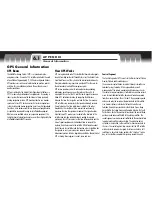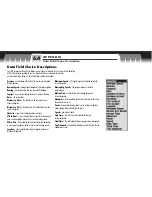
A P P E N D I X
Interference/Errors
6.3
91
Ionosphere and troposphere delays
The satellite signal slows as it passes through the atmosphere. The
system uses a built-in model that calculates an average – though
not exact – amount of delay.
Signal multi-path
This occurs when the GPS signal is reflected off objects such as tall
buildings before it reaches the receiver. This increases the travel time
of the signal, causing errors.
Receiver clock errors
The built-in clock can have very slight timing errors.
Orbital errors
Also known as ephemeris errors, these are inaccuracies of the
satellite’s reported location.
Most common error
Most common error is not having a clear view of the sky, or being
under very cloudy conditions, when a satellite signal may not
be received.
Number of satellites visible
The more satellites the receiver can see, the better the accuracy.
Buildings, terrain, electronic interference or even dense foliage can
block signal reception, resulting in position errors or possibly no
position reading at all. In general, the clearer the view of the sky is
at your location, the better the reception will be. GPS receivers will
not work indoors, underwater or underground.
Due to the errors that might occur, it is recommended that the serious
navigator use a second navigational tool, such as a magnetic compass
or map.
When satellite lock is lost
Whenever satellite lock is lost, the
following animation sequence appears on
screen and continues to loop until satellite lock is re-acquired.
When GPS is turned Off
Whenever GPS is turned Off, the following animation
sequence occurs and continues to loop until search is
activated by user.
Also, some data fields appear blank until GPS is turned On and
satellite lock is re-acquired.
Interference / Errors
GPS receivers have the potential for position errors due to interference, primarily from the following sources:








































